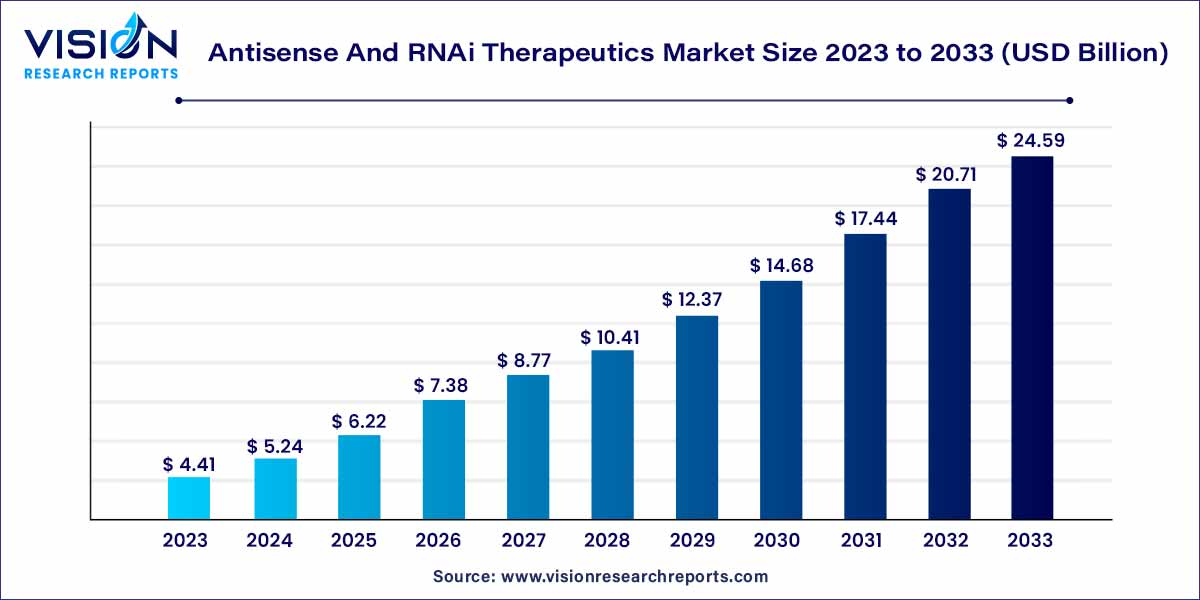The global antisense and RNAi therapeutics market size was estimated at around USD 4.41 billion in 2023 and it is projected to hit around USD 24.59 billion by 2033, growing at a CAGR of 18.75% from 2024 to 2033.

Key Pointers
- North America held the largest market share at 65% in 2023, dominating the antisense and RNAi therapeutics market.
- The European market for antisense and RNAi therapeutics is expected to experience significant growth.
- Antisense RNA technology dominated in 2023, while RNA interference technology is anticipated to have the highest CAGR of 19.56% from 2024 to 2033.
- Neurodegenerative disorders led in application with a 68% market share in 2023, while genetic disorders are projected to grow at a notable CAGR of 19.66% from 2024 to 2033.
- Intrathecal injections claimed the largest market share of 44% in 2023 for the route of administration, with subcutaneous injections expecting the highest CAGR of 19.98% from 2024 to 2033.
Antisense and RNAi Therapeutics Market Overview
Antisense and RNAi therapeutics target specific RNA molecules involved in diseases. Antisense technology uses synthetic nucleic acid sequences to modulate gene expression, while RNA interference employs small RNA molecules to silence gene expression.
Antisense and RNAi Therapeutics Market Growth
- Advancements in nucleic acid technologies contribute to the development of more efficient therapeutic agents.
- Research and development activities uncover new therapeutic targets, expanding applications.
- Demand for targeted therapies with fewer side effects drives adoption across various disease areas.
- Collaborations between pharmaceutical companies and research institutions accelerate development and commercialization.
- Favorable regulatory frameworks facilitate entry of new therapeutics, driving innovation and investment.
Get a Sample: https://www.visionresearchreports.com/report/sample/41184
Technology Insights
Application Insights
In 2023, the segment focusing on neurodegenerative disorders dominated the market, capturing the largest share of revenue at 68%. Industry players are actively pursuing advancements in RNAi and antisense therapies to address neurodegenerative diseases. Notably, in June 2023, Arrowhead Pharmaceuticals announced its intention to seek regulatory approval in Australia to initiate a study on an investigational RNA interference-based therapy for amyotrophic lateral sclerosis (ALS), a neurological disorder. Such initiatives from major companies targeting neurodegenerative conditions are expected to drive growth in this segment.
Conversely, the genetic disorders segment is projected to demonstrate the highest compound annual growth rate (CAGR) of 19.66% over the forecast period. The field of oligonucleotide medicines is rapidly expanding, evident from the increasing number of research studies. Companies are adopting diverse approaches to develop antisense and RNAi therapeutics for genetic diseases. For instance, in June 2023, Charles River Laboratories International, Inc. collaborated with the Korean biotechnology company, Curigin, to produce oncolytic RNA interference (RNAi) gene therapy.
Route Of Administration Insights
In 2023, the intrathecal injections segment emerged as the market leader, securing a 44% share. This method involves administering drugs through injection into the subarachnoid space or spinal canal to reach the cerebrospinal fluid. Intrathecal injections are commonly employed in spinal anesthesia, chemotherapy, pain management, and delivering drugs to address specific infections, particularly after neurosurgical procedures. The choice of drug administration route significantly influences the effectiveness of each genetically modified molecule.
On the contrary, the subcutaneous injection segment is positioned to experience the highest compound annual growth rate (CAGR) of 19.98% over the forecast period. Subcutaneous injections are administered into the fatty tissue just beneath the skin. This method provides flexibility in selecting the infusion site, including options such as the abdomen, thighs, and back of the arms. Additionally, subcutaneous infusion systems can employ smaller needle sizes, potentially reducing discomfort during the infusion process. The advantages associated with subcutaneous administration are expected to propel the growth of this segment in the foreseeable future.
Regional Insights
Antisense And RNAi Therapeutics Market Key Companies
- GSK plc
- Olix Pharmaceuticals, Inc.
- Sanofi
- Alnylam Pharmaceuticals, Inc.
- Arbutus Biopharma
- Benitec Biopharma Inc.
- Silence Therapeutics
- Ionis Pharmaceuticals, Inc
- Sarepta Therapeutics
- Percheron Therapeutics Limited
Antisense And RNAi Therapeutics Market Segmentations:
By Technology
- RNA Interference
- Antisense RNA
By Application
- Genetic Disease
- Cancer
- Infectious Disease
- Neurodegenerative Disorders
- Cardiometabolic & Renal Disorders
- Ocular Disorders
- Respiratory Disorders
- Skin Disorders
By Route of Administration
- Intravenous Injections
- Intrathecal Injections
- Subcutaneous Injections
- Other Delivery Methods
By Region
- North America
- Europe
- Asia Pacific
- Latin America
- MEA
Buy this Premium Research Report@ https://www.visionresearchreports.com/report/checkout/41184
You can place an order or ask any questions, please feel free to contact sales@visionresearchreports.com| +1 650-460-3308
